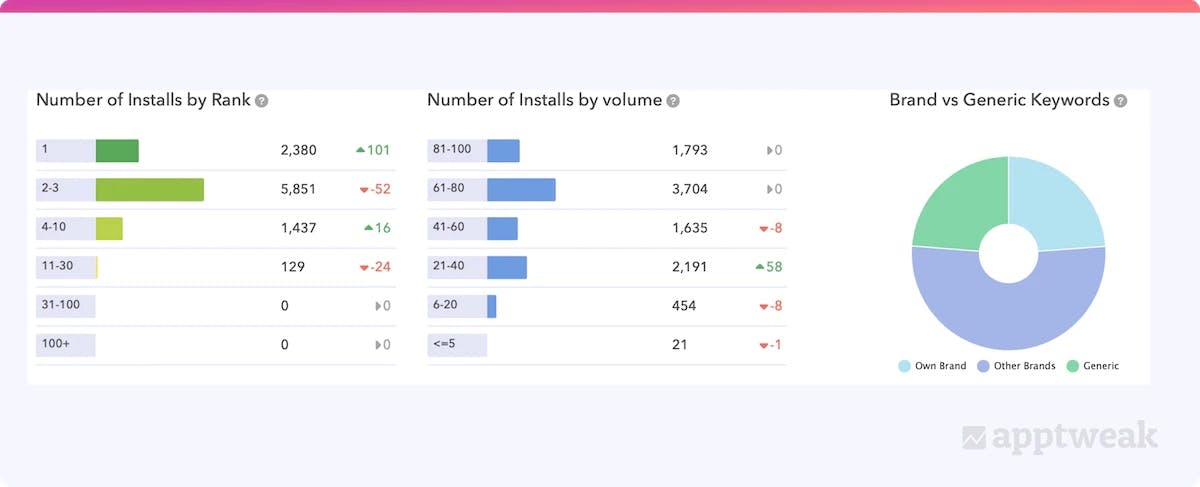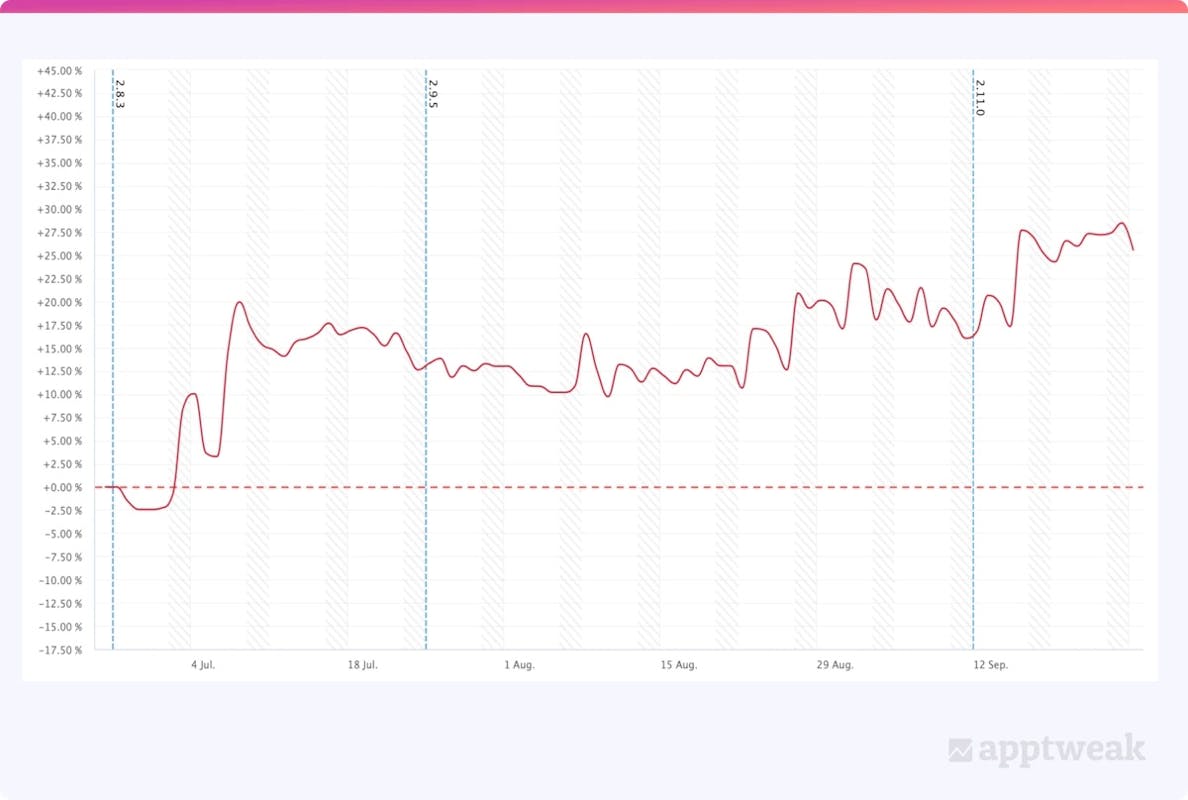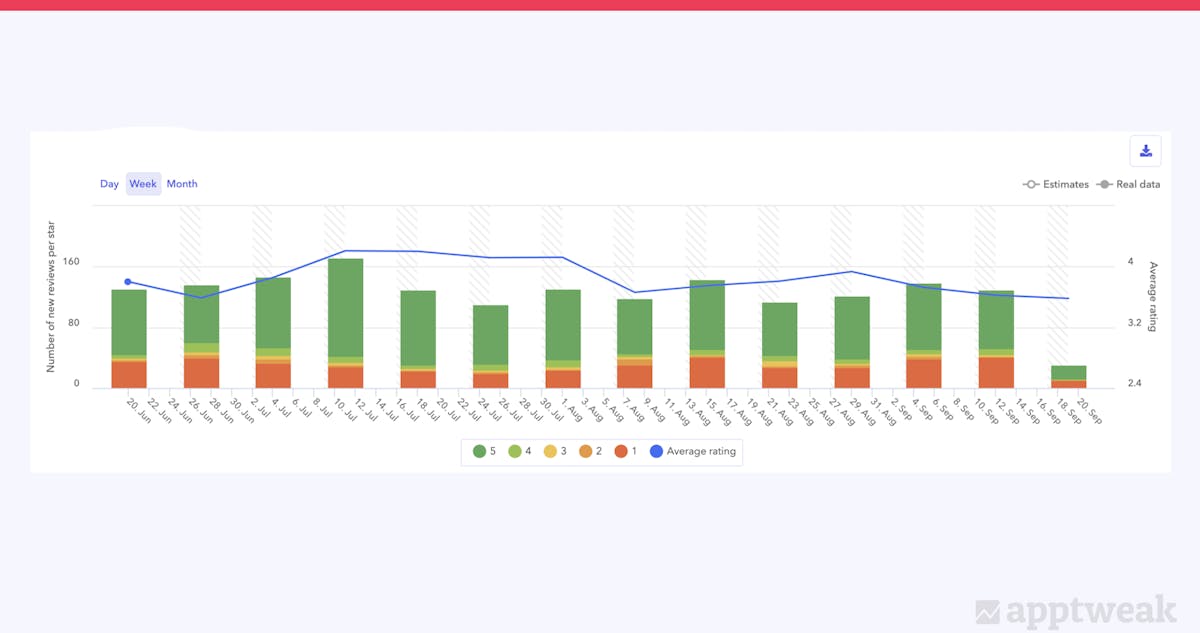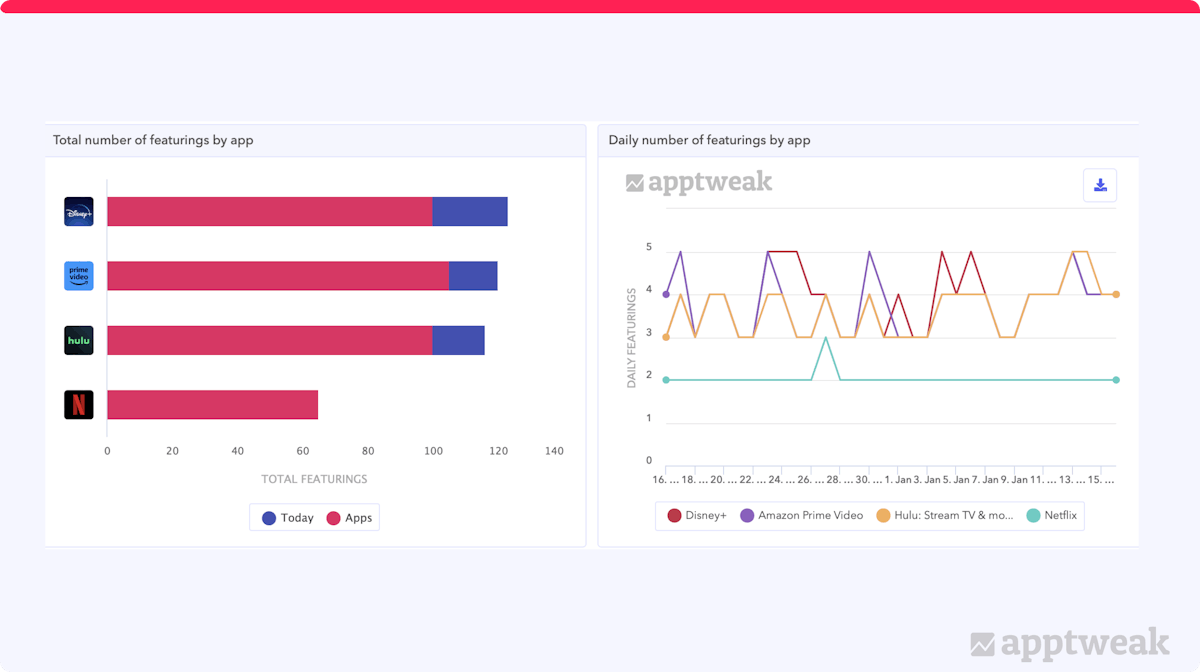
What metrics matter most when tracking ASO performance over time?
Growing an app is like taking care of a plant – it’s a long and tedious process that requires patience, time, and hard work. What is important here is to consider the ASO KPIs for your app’s success, understand what works, and identify what to improve to help your app reach more users.
In this blog, we’ve highlighted some easy tips to help you monitor your ASO performance and measure success. We will also look at the most important metrics to keep in mind when tracking your ASO progress. Spend only 15 minutes a day working on these and you’ll see a difference.
Tip #1: Improve your app visibility on the stores
One of the main goals of ASO is to improve your app’s visibility on the App Store and Google Play search results. Increasing an app’s visibility within the stores will increase the chance of your app being seen by potential users.
The primary ASO KPIs to measure your app’s visibility in the app stores are:
Impressions or store listing visitors
To measure your app’s visibility, the core metrics to look at are impressions on the App Store and store listing visitors on Google Play.
- Apple defines impressions as: “The number of times your app was viewed in the Featured, Categories, Top Charts, and Search sections of the App Store, including Product Page Views.”
- Google on the other hand, does not report on impressions. To measure visibility, you should report on store listing visitors instead. Google defines store listing visitors as: “The number of users that visited your store listing who didn’t already have your app installed on any of their devices.”
An increase in either of these metrics means that your app gained more visibility by getting featured and/or by ranking higher on a wider range of keywords.
Keyword rankings
Keyword rankings show how your app ranks on specific keywords. More specifically, keywords are terms that connect users to relevant apps they are looking for. If you’re wondering which keywords your app should target, AppTweak helps you quickly brainstorm a list of keywords to spot the best opportunities. The most desirable scenario here is to rank in the top 10 on high-volume keywords that are relevant to your app.
To successfully monitor your app’s ASO performance and KPIs, it is extremely important to be aware of how and which keywords you are ranking on. Remember that removing high-performing keywords that bring a significant number of installs to your app could be a really counterproductive move. Also, the higher the number and average volume of your keywords, the higher your app’s visibility. An app that ranks #50 or above for a total of 200 keywords with a volume score below 10 will have a lower visibility than an app that ranks on 50 keywords with an average volume equal to 40 and an average rank in the top 10.

Find out how to best optimize your app’s title to boost your app ranking
Visibility score
The visibility score is a metric that helps you understand how visible your app is in the search results compared to your competitors. Your app’s visibility score will increase if you rank high for a lot of keywords. With AppTweak, you can also determine whether your app’s visibility in the search results increased after a metadata update. Our keyword tool gives you a clear overview of the keywords that led to a growth in your app’s ranking positions over a given period of time. It considers the number of keywords your app is ranking on, the volume of the keywords, and your app’s rank on each keyword.

Tip #2: Monitor your app’s conversion rate
A strong KPI that helps performance based marketing companies and ASO experts measure your performance is your app conversion rate. App conversion rate is defined as the percentage of users who download your app after viewing its product page. Apple and Google have two different ways of defining conversion rates:
- Conversion rates on the App Store are defined as app units over unique impressions.
- Conversion rates on Google Play are store listing visitors over acquisitions.
As a result, conversion rates on the Play Store are typically much higher than on the App Store. This is because Google only accounts for people who have actually visited the app page (and have therefore already shown interest in learning more about that app).
Several strategies and techniques can help improve your app’s conversion rate. To name a few, optimizing your app’s creatives and monitoring your app’s reviews and ratings are likely to do your app good. More specifically, keyword optimization or paid acquisition campaigns might drive a lot of traffic to your app page. But it is the conversion optimization efforts that will make sure that this traffic converts users to download your app.

Tip #3: Keep an eye on your app’s reviews and ratings
Your app’s reviews and ratings are an essential KPI to measure. They are a key public indicator of your app’s health and have a strong impact on app conversion rate as people are naturally influenced by what their peers think. Reviews and ratings are immediately visible on the App Store and Google Play when users search for your app. Therefore, keeping a high average score is essential to show users that your app is qualitative and it is loved by the community.
More reviews and a high average rating score is a positive signal for users, and encourages store visitors to download your app. On the other hand, few reviews and/or low ratings might discourage users from downloading your app and will lead to lower app conversion rates. Therefore, monitoring your app’s reviews and obtaining as many positive ratings as possible will enhance your chances of having an appealing app.
Find out how to keep track of your app’s reviews & ratings with AppTweak

Tip #4: Estimate the number of organic installs
As one of the most important ASO KPIs, organic installs represent the number of installs your app generates without any advertisement efforts from your side. In particular, this refers to users installing your app after searching or browsing the stores. This makes users acquired organically of a high value, as they tend to be more engaged with your app compared to users that install your app with the help of ads.
Although the term “downloads” and “installs” are often used interchangeably, it is important to make a clear distinction between them. Keep this in mind as you may see that the two numbers for your app do not perfectly match.
- A download is counted when a user downloads your app and doesn’t consider whether the user uses it or not.
- An install is when the user launches and uses the app.
Furthermore, acquisition campaigns outside of the app stores can impact organic installs. Brand awareness campaigns on social media, for example, can result in an increase in branded searches on the app stores. Apps will see an increase in organic downloads, but these cannot necessarily be attributed to ASO activities.
To most effectively measure the uplift of your ASO efforts, it is important to carry out any ASO updates at a different moment from any major app updates or advertising changes. Also, splitting up keyword updates from creative updates will help you best measure the impact of your work.
Discover the best ways to increase app installs with tough competition

Optimizing for visibility is important, but it’s not enough to stop once you reach your visibility goal. So let’s look into some of the main KPIs you can use to measure the success of your conversion optimization efforts.
Tip #5: Get featured on the app stores
Being featured on the app stores is highly beneficial to your app growth and guarantees quality and trustworthiness for store users. Getting featured by the App Store or Google Play is a great opportunity for your app to reach new users and become more visible. To increase your chances of being featured, you first want to work on your app itself to ensure you offer users a unique and qualitative experience.
To increase your chance of getting featured on iOS, work on your storytelling and enhance elements that make your app or game different from others. For Google Play, you should first work on your app’s performance and user satisfaction.
Assess your app’s visibility after being featured on the App Store

Additional metrics to monitor your ASO efforts
Some other metrics that ASO experts should keep an eye on to monitor their app’s health and performance include:
- Active users: Users who actively use your app and engage with it are doubtless users who bring a lot of value to your app. Keeping track of the number of active users is a great KPI to measure the impact of your user acquisition strategy.
- Lapsed users: Re-engaging inactive users could be a good strategy to gain back some old users. To measure the exact number of returning users, it is important to keep track of the number of re-downloads (for Apple) or returning users (for Google).
- Retention rate: This is yet another important user engagement metric that highlights the way a user interacts with an app. Solid ASO efforts tend to drive more engaged users with a higher retention rate compared to alternative paid methods.
ASO with AppTweak Course & Certification
Authenticate your ASO and AppTweak knowledge with a certification!
Get certifiedTL;DR
There’s no one KPI in ASO that can guarantee your app’s success. It’s important to consider all relevant KPIs together and look at the bigger picture to build a robust ASO strategy. Keep a tab on these essential metrics to monitor your ASO performance and measure your app’s success:
- Look at impressions (App Store) and store listing visitors (Google Play) to measure your app’s visibility.
- Understand your keyword rankings – the higher the number and average volume of your keywords, the higher your app’s visibility.
- Check your visibility score to know how visible your app is in the search results compared to your competitors.
- Monitor your app’s reviews and ratings.
- Estimate your app’s organic installs.
- Get featured on the app stores.
- Keep an eye on additional metrics like active users, lapsed users, and retention rate.
Discover how AppTweak can help your app or game boost its visibility and downloads.
FAQ
What are the most important ASO KPIs to measure app success?
The most important ASO KPIs for measuring app success include impressions or store listing visitors, keyword rankings, visibility score, app conversion rate, reviews and ratings, organic installs, active users, lapsed users, and retention rate.
How do impressions and store listing visitors indicate app visibility?
Impressions (on the App Store) and store listing visitors (on Google Play) are core metrics that show how visible an app is in the stores. An increase in these numbers means the app is seen more often by potential users, either by being featured or by ranking higher in relevant searches.
Why is keyword ranking important for app growth?
Keyword ranking shows how well an app ranks for specific keywords that users search for. Ranking in the top spots for high-volume, relevant keywords significantly increases app visibility and the likelihood of attracting organic installs.
What is a visibility score in ASO, and why does it matter?
A visibility score reflects how visible an app is in search results compared to competitors. Higher visibility scores mean the app ranks well for many high-volume keywords, which can lead to more organic traffic and downloads.
How can I monitor and improve my app’s conversion rate?
Monitoring conversion rate, the percentage of users who download the app after viewing its product page, is crucial. Improving creatives, optimizing keyword use, and managing reviews and ratings can increase the conversion rate, turning more visitors into app users.
What are organic installs, and why are they a key ASO metric?
Organic installs are downloads that happen without any paid advertising efforts. They stem from users finding the app through search or browsing, and these users are often more engaged and valuable over time than those acquired through ads.
What additional user engagement metrics should be tracked for ASO success?
Beyond standard ASO KPIs, active users, lapsed users, and retention rate provide insights into app health and user engagement. These metrics help ASO experts refine acquisition and retention strategies.
Can ASO performance be measured with a single KPI?
There is no single KPI that determines ASO success. A combination of metrics, including visibility, keyword rankings, conversion rate, ratings, organic installs, and engagement metrics, should be tracked together for a holistic ASO strategy.



 Oriane Ineza
Oriane Ineza

 Alexandra De Clerck
Alexandra De Clerck

 Jane Jin Pak
Jane Jin Pak